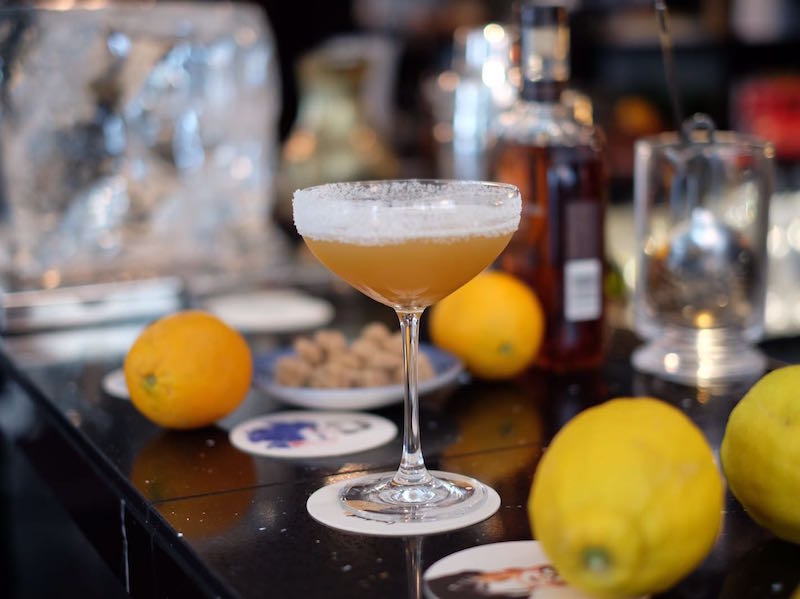Long Live the Negroni: 100 Years of the Crimson Cocktail
A century since its fateful inception, the simple yet spirituous Negroni endures as a cocktail menu mainstay. The Connaught Bar’s Giorgio Bargiani talks us through the history, cultural significance and enduring relevance of the much-loved Italian aperitivo.

Like many, I consider the Negroni to be my favourite drink. Wonderfully refreshing, bracingly bitter and packing a punch, it has become my tipple of choice, my go-to for any time of the evening, whether sipped slowly and civilly as the sun goes down, or imbibed uninhibitedly into the night, inevitably preceding questionable dance moves and a sore head the next day.
Despite my penchant for the Negroni, I’ve never thought to question its origins or history, instead spending years ordering a drink I knew little about. I’ve even gone so far as to host ‘Negroni nights’, charming guests with my over-enthusiastic pours and artfully twisted orange peel garnish, all the while ignorant of the drink’s rich heritage and important cultural significance. Sacrilege, I know.
When I learnt that this year marks a century since the Negroni’s first pour, I decided to consult an expert to learn more about the drink’s origins, evolution and burgeoning popularity. Who better to ask than Tuscan-born Giorgio Bargiani, Head Bartender at London’s iconic Connaught Bar, for whom the Negroni represents the epitome of Italian culture, intrinsically tied to family, festivities and ‘la dolce vita’...




Can you give me a brief rundown of the Negroni’s origins?
The Negroni was born in Florence in 1919, a hundred years ago. There was a noble man, his name was Count Camillo Negroni, so his surname gave the name to the drink. He was living between Florence, his city, and London, and travelling a lot. He was always drinking Americanos: bitters, vermouth and soda. But his growing familiarity with London lead him down the gin path, so once he came back to Forsco Scarselli, the barman of Cafe Casoni where he used to go to have his Negroni, he asked him to add some drops of gin to his Americano and the rest is history.
The Negroni has been around for 100 years, but it seems to have only entered mainstream cocktail culture in more recent years… why do you think this is?
I’ve got different theories. Mainly I think that if you go to Italy and ask for a Negroni, it’s like asking for pasta - it’s special yes, but it’s not that special, it’s something that we’ve always been drinking. I believe that around 10 years ago, the gin craze started so now we have millions of gin brands. More lately, the Italian amaro and bitter craze started as well. So if you go for example to the US, one of the main markets for alcohol in the world, what you get is a lot of bitter, amaro, vermouth. They’re really popular again and new brands are coming out or iconic brands are trying to expand and doing more and more. So the gin, as I said, has been very strong in the last 10, 12 maybe 15 years, and now together with the bitters and amaro and vermouth, the Negroni is the best combination that you can use to glorify all of them. At the same time, from a more romantic point of view, a Negroni is a drink you can have before dinner or you can have after dinner. It makes everyone happy. From a bartender’s point of view, you can play a lot with the Negroni, because despite there being only three ingredients, you can change all of them so the combinations are countless.
What is the significance of the Negroni in Italian culture?
It’s the symbol of the aperitivo. You know, when you go for aperitivo, you really need something to stimulate your appetite. That is what aperitivo means. Aperire in latin means ‘open’, so it will open my appetite somehow. Everyone in Italy - every bartender, every old lady - is able to make a Negroni and glorify this moment of the day, which is a moment when people after work meet and socialise.


What do you think makes a Negroni so iconic?
Italia! Our culture is spread around the world, and people recognise a few elements, such as - well pizza, pasta, whatever. Although the chefs are more recognised around the world, the bartenders are also playing their part in the visibility as well, and what could be better than the Negroni? Easy to make, you can buy the ingredients everywhere, it’s good for the bartender to make and even better for the consumer to drink. The name as well for me is very important, because few know its origins but everyone likes pronouncing it. Sometimes I believe people order it just for the name. “I want a Negroni. What is a Negroni? Ah it doesn’t even matter, I just want a Negroni”. The Negroni is a great ambassador of Italian culture.
What are the key qualities of a good Negroni?
For sure it’s the balance between the three ingredients, which might look easy because it’s an equal part recipe - one part gin, one part vermouth, one part bitters - but it’s easy to create an unbalanced drink, such as when you have too aromatic a gin or too powerful a vermouth or too bitter bitters. If you have a Negroni in Italy, it’s made with the simplest gin, vermouth and bitters. Campari bitters is the one that’s recognised the most for the Negroni, but then the sweet vermouth is the Martini and the gin could be Tanqueray or Bombay, which are probably the most popular brands in the world.
What do you personally love about the Negroni?
You can drink the Negroni anytime, anywhere. You shouldn’t really find a reason not to drink Negroni because Negroni gives you a reason to be drunk and really brings people together, really creates this social moment. It’s close to my heart.
In recent years the Negroni has seen many reinterpretations. What do you make of this new wave of the traditional cocktail?
We’re living in a world that changes everyday, so for me there’s nothing really wrong if people still keep changing the drink. Because Negroni will always be Negroni and people will still recognise it for the next 100 years. But for me it doesn’t lose the soul that’s always been there since 1919 when Camillo Negroni was drinking 40 a day!




